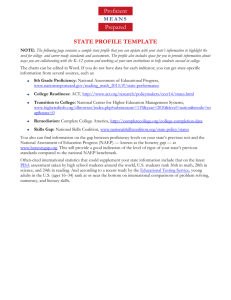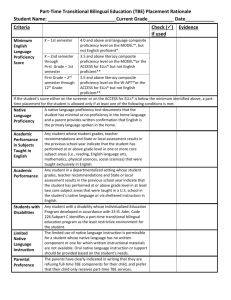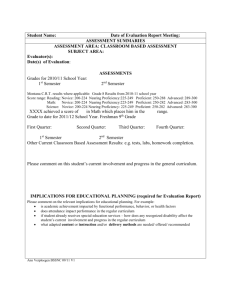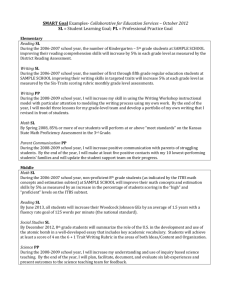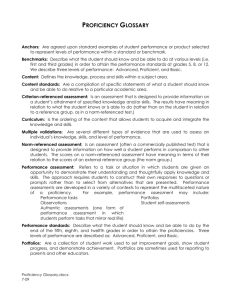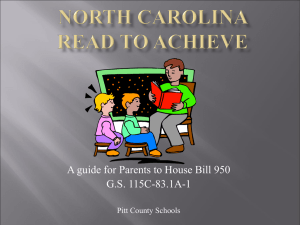2013 ETS Proficiency Profile Results
advertisement
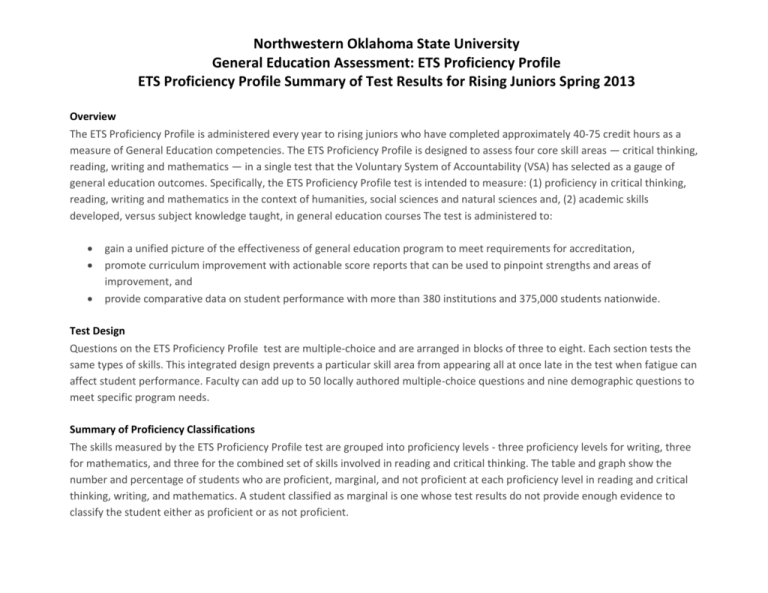
Northwestern Oklahoma State University General Education Assessment: ETS Proficiency Profile ETS Proficiency Profile Summary of Test Results for Rising Juniors Spring 2013 Overview The ETS Proficiency Profile is administered every year to rising juniors who have completed approximately 40-75 credit hours as a measure of General Education competencies. The ETS Proficiency Profile is designed to assess four core skill areas — critical thinking, reading, writing and mathematics — in a single test that the Voluntary System of Accountability (VSA) has selected as a gauge of general education outcomes. Specifically, the ETS Proficiency Profile test is intended to measure: (1) proficiency in critical thinking, reading, writing and mathematics in the context of humanities, social sciences and natural sciences and, (2) academic skills developed, versus subject knowledge taught, in general education courses The test is administered to: gain a unified picture of the effectiveness of general education program to meet requirements for accreditation, promote curriculum improvement with actionable score reports that can be used to pinpoint strengths and areas of improvement, and provide comparative data on student performance with more than 380 institutions and 375,000 students nationwide. Test Design Questions on the ETS Proficiency Profile test are multiple-choice and are arranged in blocks of three to eight. Each section tests the same types of skills. This integrated design prevents a particular skill area from appearing all at once late in the test when fatigue can affect student performance. Faculty can add up to 50 locally authored multiple-choice questions and nine demographic questions to meet specific program needs. Summary of Proficiency Classifications The skills measured by the ETS Proficiency Profile test are grouped into proficiency levels - three proficiency levels for writing, three for mathematics, and three for the combined set of skills involved in reading and critical thinking. The table and graph show the number and percentage of students who are proficient, marginal, and not proficient at each proficiency level in reading and critical thinking, writing, and mathematics. A student classified as marginal is one whose test results do not provide enough evidence to classify the student either as proficient or as not proficient. ETS Proficiency Profile Summary of Proficiency Classifications To show how many students are proficient at each level Cohort Name: Mid-Level Spring 2013 Close Date: 05/31/13 Student Level: All Northwestern Oklahoma State University Abbreviated Form Test Description: Abbreviated Form B Number of students tested: 183 Number of students included in these statistics: 180 Number of students excluded (see roster): 3 Skill Dimension Reading, Level 1 Reading, Level 2 Critical Thinking Northwestern Rising Juniors 2013 ETS Proficiency Profile Baccalaureate I & II Sophomores 40-75 credits hrs n=180 Proficiency Classification Not Proficient Marginal Proficient 61% 18% 22% 32% 18% 49% 1% 23% 76% 30-60 credit hrs n=6,592 Proficiency Classification Not Proficient Marginal Proficient 56% 22% 22% 26% 18% 56% 3% 12% 85% Writing, Level 1 Writing, Level 2 Writing, Level 3 58% 14% 6% 29% 34% 22% 13% 52% 72% 53% 13% 5% 32% 32% 20% 15% 54% 75% Mathematics, Level 1 Mathematics, Level 2 Mathematics, Level 3 50% 18% 4% 31% 30% 11% 19% 52% 86% 39% 17% 4% 29% 22% 10% 32% 61% 87% Proficiency Measures In addition to a total score, proficiency classifications (proficient, marginal or not proficient) measure how well your students have mastered each level of proficiency within three skill areas: Reading/Critical Thinking Level I Students who are proficient can: recognize factual material explicitly presented in a reading passage understand the meaning of particular words or phrases in the context of a reading passage Level II Students who are proficient can: synthesize material from different sections of a passage recognize valid inferences derived from material in the passage identify accurate summaries of a passage or of significant sections of the passage understand and interpret figurative language discern the main idea, purpose or focus of a passage or a significant portion of the passage Level III Students who are proficient can: evaluate competing causal explanations evaluate hypotheses for consistency with known facts determine the relevance of information for evaluating an argument or conclusion determine whether an artistic interpretation is supported by evidence contained in a work recognize the salient features or themes in a work of art evaluate the appropriateness of procedures for investigating a question of causation evaluate data for consistency with known facts, hypotheses or methods recognize flaws and inconsistencies in an argument Writing Skills Level I Students who are proficient can: recognize agreement among basic grammatical elements (e.g., nouns, verbs, pronouns and conjunctions) recognize appropriate transition words recognize incorrect word choice order sentences in a paragraph order elements in an outline Level II Students who are proficient can: incorporate new material into a passage recognize agreement among basic grammatical elements (e.g., nouns, verbs, pronouns and conjunctions) when these elements are complicated by intervening words or phrases combine simple clauses into single, more complex combinations recast existing sentences into new syntactic combinations Level III Students who are proficient can: discriminate between appropriate and inappropriate use of parallelism discriminate between appropriate and inappropriate use of idiomatic language recognize redundancy discriminate between correct and incorrect constructions recognize the most effective revision of a sentence Mathematics Level I Students who are proficient can: solve word problems that would most likely be solved by arithmetic and do not involve conversion of units or proportionality. These problems can be multi-step if the steps are repeated rather than embedded. solve problems involving the informal properties of numbers and operations, often involving the Number Line, including positive and negative numbers, whole numbers and fractions (including conversions of common fractions to percent, such as converting "1/4" to 25%) solve problems requiring a general understanding of square roots and the squares of numbers solve a simple equation or substitute numbers into an algebraic expression find information from a graph. This task may involve finding a specified piece of information in a graph that also contains other information. Level II Students who are proficient can: solve arithmetic problems with some complications, such as complex wording, maximizing or minimizing, and embedded ratios. These problems include algebra problems that can be solved by arithmetic (the answer choices are numeric). simplify algebraic expressions, perform basic translations, and draw conclusions from algebraic equations and inequalities. These tasks are more complicated than solving a simple equation, though they may be approached arithmetically by substituting numbers. interpret a trend represented in a graph, or choose a graph that reflects a trend solve problems involving sets; problems have numeric answer choices Level III Students who are proficient can: solve word problems that would be unlikely to be solved by arithmetic; the answer choices are either algebraic expressions or numbers that do not lend themselves to back-solving solve problems involving difficult arithmetic concepts such as exponents and roots other than squares and square roots and percent of increase or decrease generalize about numbers (e.g., identify the values of (x) for which an expression increases as (x) increases) solve problems requiring an understanding of the properties of integers, rational numbers, etc. interpret a graph in which the trends are to be expressed algebraically or one of the following is involved: exponents and roots other than squares and square roots, percent of increase or decrease solve problems requiring insight or logical reasoning
